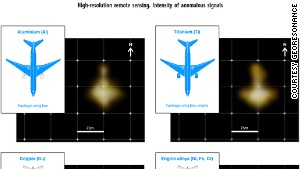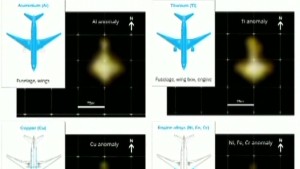Malaysian Chronicle......





Star Online......
Thursday, 01 May 2014 12:52
'We're a LARGE group of scientists & we were being IGNORED' - Aussie firm on its MH370 'FIND'
Rate this item
(0 votes)
The Australian company GeoResonance claims it has found the wreckage of a plane in the Bay of Bengal. The company is not saying that what they found is missing Malaysia Airlines Flight 370, but it is urging official searchers to take a look. So far, Malaysian officials say they are investigating the credibility of the claim, while Australian searchers and a satellite company say they are confident that the plane is in a different area.
What is GeoResonance?
GeoResonance specializes in geophysical surveys. The company's technology has been used to find oil and gas, groundwater, uranium, even diamonds.
The technology the company uses was originally created to search for nuclear, biological and chemical weaponry under the ocean or beneath the earth in bunkers, said David Pope, the company's director.

A graphic from GeoResonance shows images depicting underwater "anomalies" suggesting deposits of various metals in the approximate formation of a passenger airliner on the floor of the Bay of Bengal.

Photos: The search for Malaysia Airlines Flight 370

Company: These images may be MH370

Company: 'Confident' we found wreckage
"Subsurface exploration has never been so precise -- we detect the nuclei of targeted substances," the company says on its website.
In addition to finding natural resources, the company has also used its resources to located submerged structures, including ships and aircraft.
What technology is the company using?
According to an Australian newspaper account, GeoResonance makes use of former Soviet defense technology that has since been demilitarized.
It analyzes super-weak electromagnetic fields captured by airborne multispectral images.
"And what we do is we look at the nuclei of an atom, copper or nickel or iron. And so we knew we had the tools to search for the plane," Pope said.
For their search of MH370, the company began by looking for aluminum, which makes up about 70% of the Boeing 777, Pope said.
Once it got a hit for aluminum, it looked for other metals such as titanium, copper, steel, nickel, iron and chromium, he said.
The result is a set of images that show what could be the parts of an intact plane.
Where is this site?
Pope declined to give the precise coordinates for GeoResonance's find, but said it was about 120 miles (190 kilometers) south of Bangladesh in the Bay of Bengal. The search officials do have the exact location, he said.
The current official search area is in the southern Indian Ocean, and is being coordinated by the Australians. The site where GeoResonance says it found the wreckage is several thousand miles away in an area that was ruled out weeks ago.
Pope said his company began searching that area at a time when search efforts were in the Bay of Bengal. The search moved on, but his team sent their findings to officials repeatedly, he said.
Did officials ignore the company's findings?
According to GeoResonance, yes, its e-mails and phone calls to the official searchers went unanswered. That is one of the factors that pushed the company to release its findings publicly.
Pope says he did not want to share the findings publicly at first, but it was possibly the only way to get heard.
"We're a large group of scientists, and we were being ignored, and we thought we had a moral obligation to get our findings to the authorities," he said.
The strategy appears to have worked, according to Pope.
On the same day he released the findings, Malaysian officials reached out and listened to a 1½-hour technical presentation by his team. Malaysian acting Transportation Minister Hishammuddin Hussein said Malaysia "is working with its international partners to assess the credibility of this information."
Australia's Joint Agency Coordination Centre, which is leading the multinational search, dismissed the claim. The officials are "satisfied" with data that show the plane likely is in the southern Indian Ocean, and not in the Bay of Bengal. - CNN
Thursday, 01 May 2014 13:03
AT LAST, MH370 searchers ask Bangladesh to send ships to check on Bay of Bengal lead
Rate this item
(1 Vote)
Even as they were rejecting as far-fetched an Australian company's assertion that it may have identified the resting place of Malaysia Airlines Flight 370 -- thousands of miles from where investigators have been searching -- experts acknowledged Wednesday that they have little choice but to check it out.
"The investigators are going to be hard-pressed to blow this off," said Mary Schiavo, a former inspector general for the Department of Transportation. "I think, at this point, because of the lack of results where they've been searching for six weeks, they're almost stuck. They have to go look."
The Adelaide-based firm GeoResonance has said that electromagnetic fields captured by airborne multispectral images some 118 miles (190 kilometers) off the coast of Bangladesh in the Bay of Bengal showed evidence of aluminum, titanium, copper and other elements that could have been part of the Boeing 777-200ER, which disappeared from radar on March 8 while en route from Kuala Lumpur, Malaysia, to Beijing.
"The company is not declaring this is MH370, however it should be investigated," GeoResonance said Tuesday in a news release.
GeoResonance Managing Director Pavel Kursa, citing intellectual property concerns, would not explain how the imaging works.
Bangladesh sends 2 navy frigates to search & verify Geo's information

Photos: The search for Malaysia Airlines Flight 370
Nevertheless, the company got its wish on Wednesday, when Bangladesh sent two navy frigates into the Bay of Bengal to the location cited by GeoResonance. "As soon as they get there, they will search and verify the information," Commodore Rashed Ali, director of Bangladesh navy intelligence, told CNN in Dhaka.
The chief coordinator of the Joint Agency Coordination Centre, retired Chief Air Marshal Angus Houston, held out little optimism that any such search would prove fruitful. He told Sky News International that the search area in the Indian Ocean had been set based on pings believed to have emanated from one or both of the plane's voice and data recorders. "The advice from the experts is that's probably where the aircraft lost power and, somewhere close to that, it probably entered the water."
CNN aviation expert Miles O'Brien said GeoResonance's claims are not supported by experts. "My blood is boiling," he told CNN's "New Day." "I've talked to the leading experts in satellite imaging capability at NASA, and they know of no technology that is capable of doing this. I am just horrified that a company would use this event to gain attention like this."
He called on company officials to offer "a full explanation" for their assertion, which he said appeared to be based on "magic box" technology.
Sending investigators to the Bay of Bengal would draw away from the limited resources that are focused in the southern Indian Ocean, O'Brien said.
But that won't stop them from going, he predicted. "I think they have to," he said. "It's a public relations thing now."
David Gallo, director of special projects at the Woods Hole Oceanographic Institution, also expressed skepticism. "It's so revolutionary, and I don't know anyone that knows of this kind of technology," he told CNN. "And I know most of the people in this business."
'We were being ignored'
The company's director, David Pope, said he had not wanted to go public, but did so only after his information was disregarded.
"We're a large group of scientists, and we were being ignored, and we thought we had a moral obligation to get our findings to the authorities," he told CNN's "New Day" on Tuesday.
GeoResonance's technology was created to search for nuclear, biological and chemical weaponry under the ocean's surface or beneath the earth in bunkers, Pope said.
Star Online......





No comments:
Post a Comment